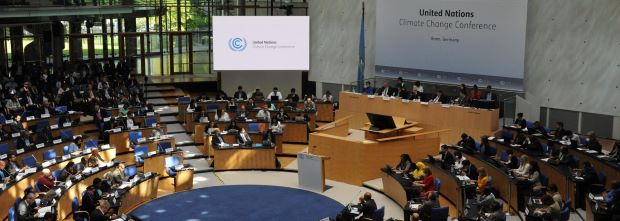March 21 in History
1994 – The United Nations Framework Convention on Climate Change enters into force
The United Nations Framework Convention on Climate Change (UNFCCC), the UN process for negotiating an agreement to limit dangerous climate change entered into force on this day in 1994.
An international treaty among countries to combat “dangerous human interference with the climate system“, in part by stabilizing greenhouse gas concentrations in the atmosphere, it was signed in 1992 by 154 states at the United Nations Conference on Environment and Development (UNCED), informally known as the Earth Summit, held in Rio de Janeiro. The
‘UNFCCC’ is also the name of the Secretariat charged with supporting the operation of the convention, with offices on the UN Campus in Bonn, Germany.
Article 2 of the Convention sets out the ultimate objective: “stabilization of greenhouse gas concentrations in the atmosphere at a level that would prevent dangerous anthropogenic [i.e., human-caused] interference with the climate system”. The treaty called for ongoing scientific research and regular meetings, negotiations, and future policy agreements designed to allow ecosystems to adapt naturally to climate change, to ensure that food production is not threatened and to enable economic development to proceed in a sustainable manner.
The UNFCCC’s work currently focuses on implementing the Paris Agreement, entered into force in 2016 that aims to limit the rise in global temperature to well below 2ºC (3.6ºF) above levels before the industrial revolution while aiming to hold it at 1.5ºC (2.7ºF). The Paris Agreement superseded the UNFCCC’s Kyoto Protocol signed in 1997 and ran from 2005 to 2020. It was the first implementation of measures under the UNFCCC.
By 2022, the UNFCCC had 198 parties. Its supreme decision-making body, the Conference of the Parties (COP), meets annually, with other meetings at the regional and technical level taking place throughout the year. The Paris Agreement mandates a review or “global stocktake” of progress towards meeting its goals every five years. The first of these took place at COP28 in the United Arab Emirates (UAE) in 2023.
The treaty established different responsibilities for three categories of signatory states. These categories are developed countries, developed countries with special financial responsibilities, and developing countries. The developed countries, also called Annex 1 countries, originally consisted of 38 states, 13 of which were Eastern European states in transition to democracy and market economies, and the European Union. All belong to the Organization for Economic Co-operation and Development (OECD).
Annex I countries are called upon to adopt national policies and take corresponding measures on the mitigation of climate change by limiting their anthropogenic emissions of greenhouse gases as well as to report on steps adopted with the aim of returning individually or jointly to their 1990 emission levels. Developed countries with special financial responsibilities are called Annex II countries. They include all Annex I countries with the exception of those in transition to democracy and market economies. Annex II countries are called upon to provide new and additional financial resources to meet the costs incurred by developing countries in complying with their obligation to produce national inventories of their emissions by sources and their removals by sinks for all greenhouse gases not controlled by the Montreal Protocol. Developing countries are then required to submit their inventories to the UNFCCC secretariat.
Because key signatory states are not adhering to their individual commitments, the UNFCCC has been criticized as being unsuccessful in reducing the emission of carbon dioxide since its adoption. Parties to the convention have also failed to agree on a process allowing for majority voting. All decisions are taken by consensus, giving individual parties or countries a veto. The effectiveness of the Paris Agreement in reaching its climate goals is under debate, with most experts saying it is insufficient for its more ambitious goal of keeping global temperature rise under 1.5 °C” There are also debates surrounding possible enforcement mechanisms, historical responsibility for greenhouse gas emissions (climate justice), and financial support for developing countries (for example through the Green Climate Fund).
-Wikipedia



Comments are closed, but trackbacks and pingbacks are open.